Wacom CTL470 User Manual
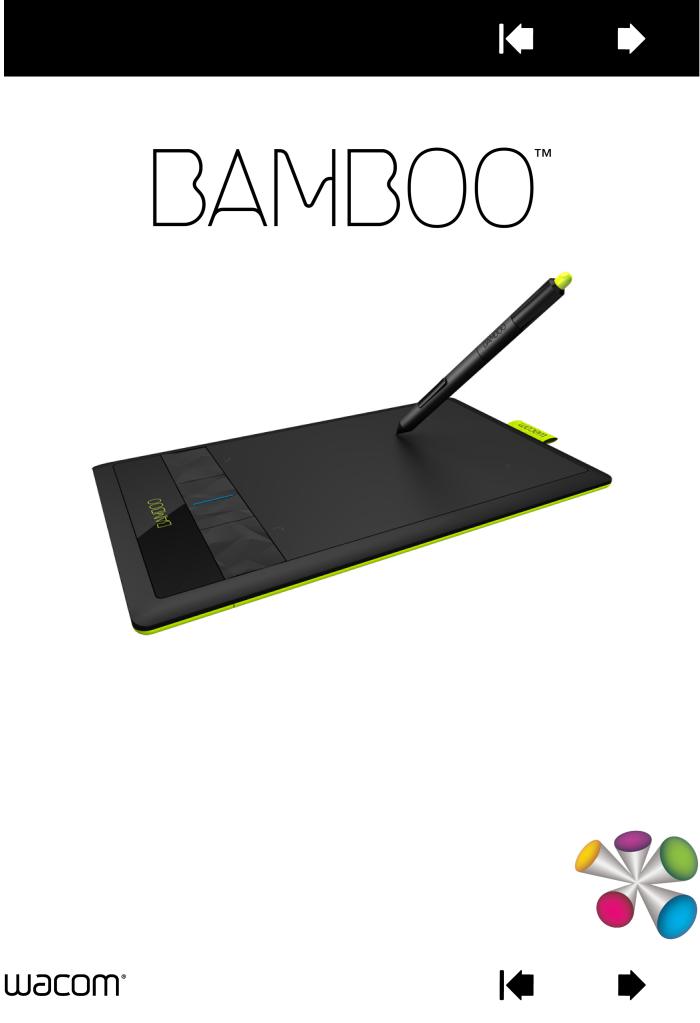
Contents Index
1
User’s manual
Bamboo (CTH-470, CTH-670)
Bamboo Pen (CTL-470)
Setting up
Navigating with touch
Customizing touch
Using the ExpressKeys
Using a pen
Customizing a pen
Going Wireless
Troubleshooting
Contents Index
1

Contents Index
2
BambooTM
User’s Manual
Version 1.0, Rev G1511
Copyright © Wacom Co., Ltd., 2011
All rights reserved. No part of this manual may be reproduced except for your express personal use.
Wacom reserves the right to revise this publication without obligation to provide notification of such changes. Wacom does its best to provide current and accurate information in this manual. However, Wacom reserves the right to change any specifications and product configurations at its discretion, without prior notice and without obligation to include such changes in this manual.
The above year indicates when this manual was prepared. However, the date of release to the users of the “manual” is simultaneous with the introduction into the market of the applicable Wacom product.
Bamboo is a trademark and Wacom is a registered trademark of Wacom Co., Ltd.
Adobe and Photoshop are either registered trademarks or trademarks of Adobe Systems Incorporated in the United States and/or other countries. Microsoft, Windows, and Vista are either registered trademarks or trademarks of Microsoft Corporation in the United States and/or other countries. Apple, the Apple logo, and Mac are trademarks of Apple, Inc., registered in the U.S. and other countries.
Any additional company and product names mentioned in this documentation may be trademarked and/or registered as trademarks. Mention of third-party products is for information purposes only and constitutes neither an endorsement nor a recommendation. Wacom assumes no responsibility with regard to the performance or use of these products.
ExpressKey is a registered trademark of Ginsan Industries, Inc., and is used with permission.
Contents Index
2
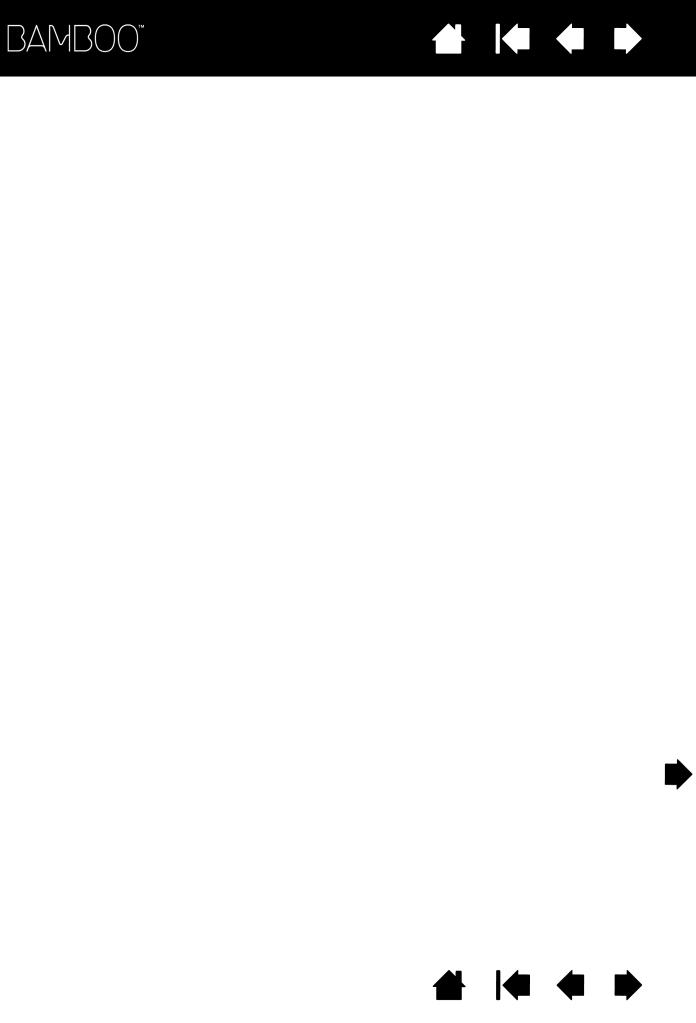
Contents Index
3
TABLE OF CONTENTS
About the manual
YOUR BAMBOO
Identify your tablet model
Bamboo tablet
Bamboo Pen tablet
Pen
Pen holder
SETTING UP YOUR BAMBOO
Ergonomics
Configuring the tablet orientation
Understanding the tablet active area
Working with multiple monitors
Control panel basics
USING YOUR BAMBOO
The touch experience with Bamboo Navigating with touch Customizing touch
The pen experience with Bamboo Holding the pen
Using the pen on the tablet Positioning
Clicking
Dragging
Using the pen buttons
Writing and drawing with pressure sensitivity Erasing
Eye-hand coordination exercise Customizing pen input
Tablet controls ExpressKey basics
Customizing the ExpressKeys
5 |
CUSTOMIZING YOUR BAMBOO |
35 |
|
6 |
Opening the control panel |
35 |
|
Control panel overview |
36 |
||
6 |
|||
Customize your touch experience |
37 |
||
7 |
|||
Setting the touch options |
37 |
||
8 |
|||
Setting the touch functions |
38 |
||
9 |
|||
Disabling touch |
39 |
||
9 |
|||
Customize your pen experience |
40 |
||
10 |
|||
Setting the tip and eraser feel, |
|
||
10 |
and double-click distance |
41 |
|
12 |
Setting the pen button functions |
42 |
|
13 |
Setting the tablet mapping |
43 |
|
15 |
Portion of screen area |
45 |
|
15 |
Portion of tablet area |
45 |
|
16 |
Setting the pen speed in mouse mode |
46 |
|
Customizing tablet and ExpressKey functions |
47 |
||
16 |
|||
Customizing the Pop-up Menu |
48 |
||
17 |
|||
Working with Display Toggle |
49 |
||
25 |
|||
Button functions |
50 |
||
26 |
|||
|
|
||
26 |
GOING WIRELESS WITH YOUR BAMBOO |
55 |
|
27 |
Wireless accessory components |
55 |
|
27 |
Wireless setup |
56 |
|
29 |
Establishing a wireless connection |
57 |
|
29 |
Optimizing the wireless connection |
59 |
|
30 |
Battery and power management |
60 |
|
31 |
Charging the battery |
60 |
|
32 |
Battery and wireless connection status |
61 |
|
33 |
Power saving features |
62 |
|
33 |
Battery life information |
63 |
|
33 |
Replacing the battery |
64 |
|
34 |
Wireless module removal |
65 |
|
34 |
Wireless receiver storage |
66 |
Contents Index
3

Contents Index
PROBLEMS WITH YOUR BAMBOO? |
67 |
Testing your tablet |
68 |
Testing a pen |
70 |
Troubleshooting tables |
71 |
General problems |
71 |
Touch input problems |
72 |
Pen input problems |
73 |
Wireless connection problems |
75 |
Windows-specific problems |
77 |
Mac-specific problems |
78 |
Technical support options |
80 |
Obtaining driver downloads |
81 |
Contents Index
|
4 |
APPENDIX |
82 |
Caring for Bamboo |
82 |
Replacing the pen nib |
83 |
Bamboo Dock |
84 |
Uninstalling Bamboo |
84 |
Managing preferences |
85 |
Pen and digital ink capabilities in Windows |
86 |
Product information |
87 |
Ordering parts and accessories |
88 |
Available parts and accessories |
88 |
GLOSSARY |
89 |
INDEX |
92 |
4
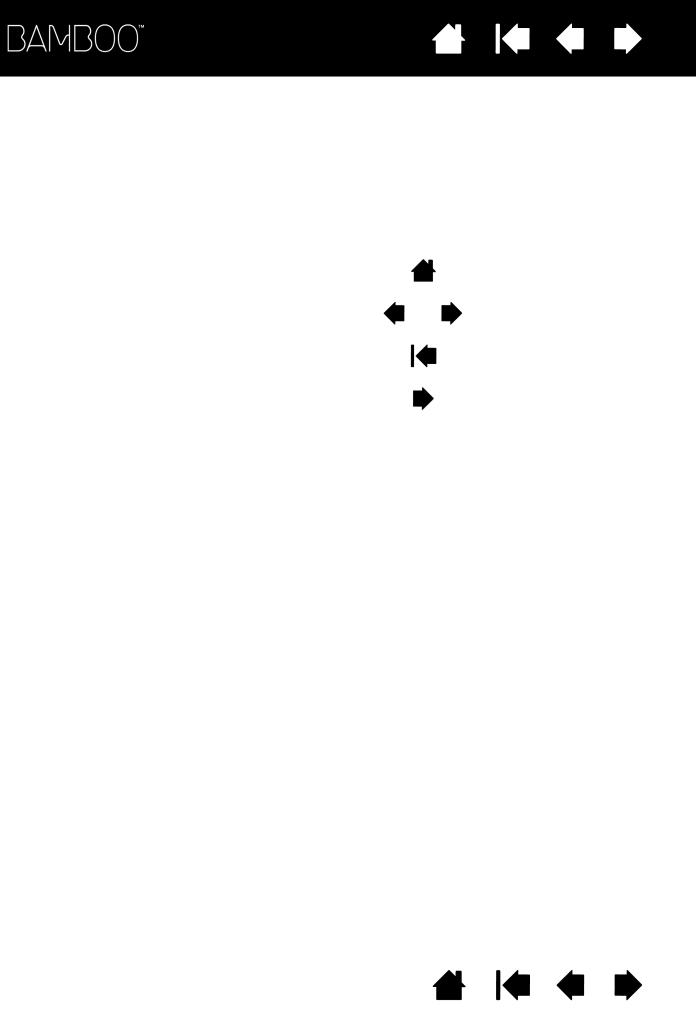
Contents Index
5
ABOUT THE MANUAL
This manual provides quick access to information about your Bamboo. The information is common to Windows and Mac computers and Windows screen captures are shown, unless otherwise noted.
•Go directly to table of contents or index topics by clicking on them.
•Use the navigation controls to move through the manual.
|
|
Go to front page. |
Contents |
Go to table of contents. |
Page back, or page forward. |
Index |
Go to index. |
Go back to previous view. |
topic |
Go to topic. |
Topic continued. |
•You can use your .pdf viewer zoom-in tool to increase the size of the manual on your display screen. Most .pdf viewers include additional tools for using and printing the manual. See the viewer application help for more information.
•SMALL CAPITAL LETTERS are used to identify the names of keyboard keys, dialog boxes, and control panel options.
•Be sure to see also the Important Product Information guide for Bamboo, located on the Bamboo Installation CD. The guide includes product safety precautions, specifications, and your license agreement.
•The following information is not included with this product: information about your specific computer hardware or operating system, or information about your application software. Your best source for this information is the set of manuals and discs that came with your hardware, operating system, or application.
•In addition to the built-in inking support found within Microsoft Windows 7 and Vista, many graphics applications also support pressure sensitivity and the pen eraser (when equipped). You can find a listing of applications that support these features on Wacom’s web site (see product information).
•For information on how best to use Bamboo features within a specific application, see the instructions in that application’s manuals.
Note: This manual does not describe how to install your Wacom tablet. Please refer to your product Quick Start Guide, and use the automated software installer (located on the Bamboo Installation CD).
Wacom’s philosophy is to continually improve all of its products. As a result, engineering changes and improvements are made from time to time. Therefore, some changes, modifications, and improvements may not be covered in this manual.
Contents Index
5

Contents Index
6
YOUR BAMBOO
This section introduces you to your Bamboo. The quickest way to learn about your Bamboo tablet is to become familiar with its appearance and features.
•Not all product models are available in all regions.
•Your Bamboo tablet can only be used with compatible Wacom pens or input devices. Wacom cannot guarantee compatibility with older tablets or pens. You cannot use pens or input devices from a previous version Bamboo tablet. Nor can a pen from your new Bamboo tablet be used with other Wacom tablets or a previous version Bamboo tablet.
Identify your tablet model
Bamboo tablet
Bamboo Pen tablet
Pen
Pen holder
IDENTIFY YOUR TABLET MODEL
Each tablet model within the Bamboo family has a specific feature set. Not all models are available in all regions.
TABLET MODEL |
TOUCH INPUT |
PEN INPUT |
EXPRESSKEYS |
|
|
|
|
Bamboo |
X |
X |
X |
(models CTH-470, CTH-670) |
|
|
|
Bamboo Pen |
|
X |
|
(model CTL-470) |
|
|
|
Icons are located near some of the topic headings in this manual. Use them to quickly identify sections that have information specific to touch or pen input.
•Touch input is identified by this icon:
•Pen input is identified by this icon:
Icons do not appear in common sections that may apply to all Bamboo tablet models.
Model-specific notes may be used as necessary.
Contents Index
6
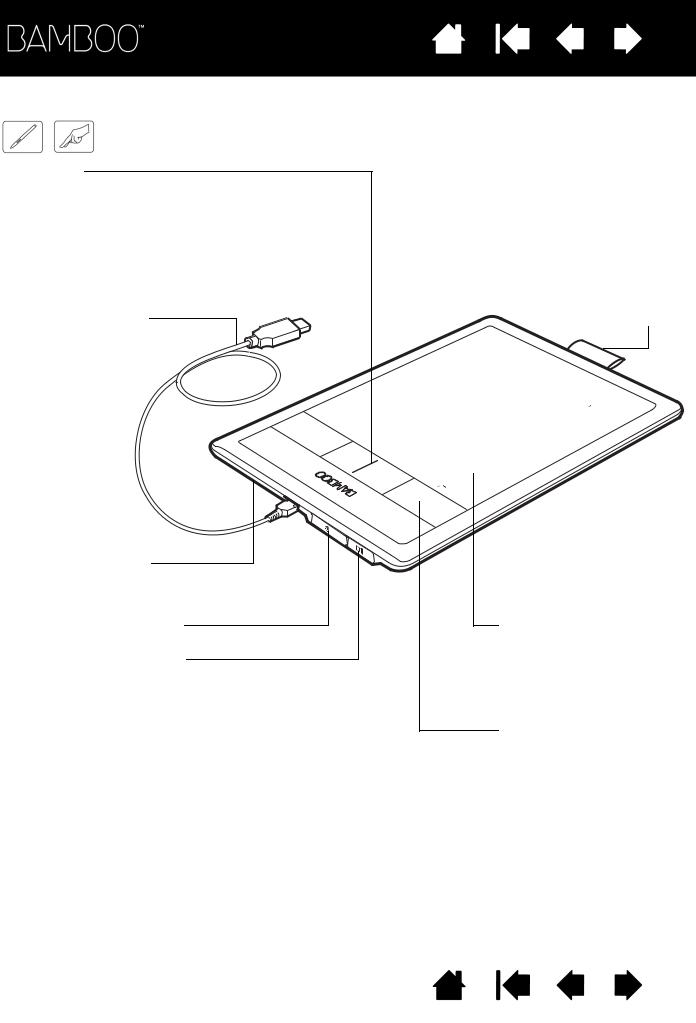
Contents Index
BAMBOO TABLET
Status LED
Glows blue when Bamboo is connected to an active USB port. Brightens when you touch the active area or press an ExpressKey.
Glows white when using the pen.
For wireless operation, see battery and wireless connection status.
USB cable, detachable
Disconnect the USB cable when storing Bamboo. Do not wrap the cable around the tablet.
Battery compartment, located beneath tablet
See wireless setup.
Wacom wireless module slot
Storage compartment, for Wacom wireless receiver
See going wireless with your Bamboo.
Contents Index
7
Pen holder
Bamboo (model CTH-470 shown)
Active area
This is the active area for pen and touch input. Learn about the pen experience and touch experience with Bamboo.
Customizable ExpressKeys
7
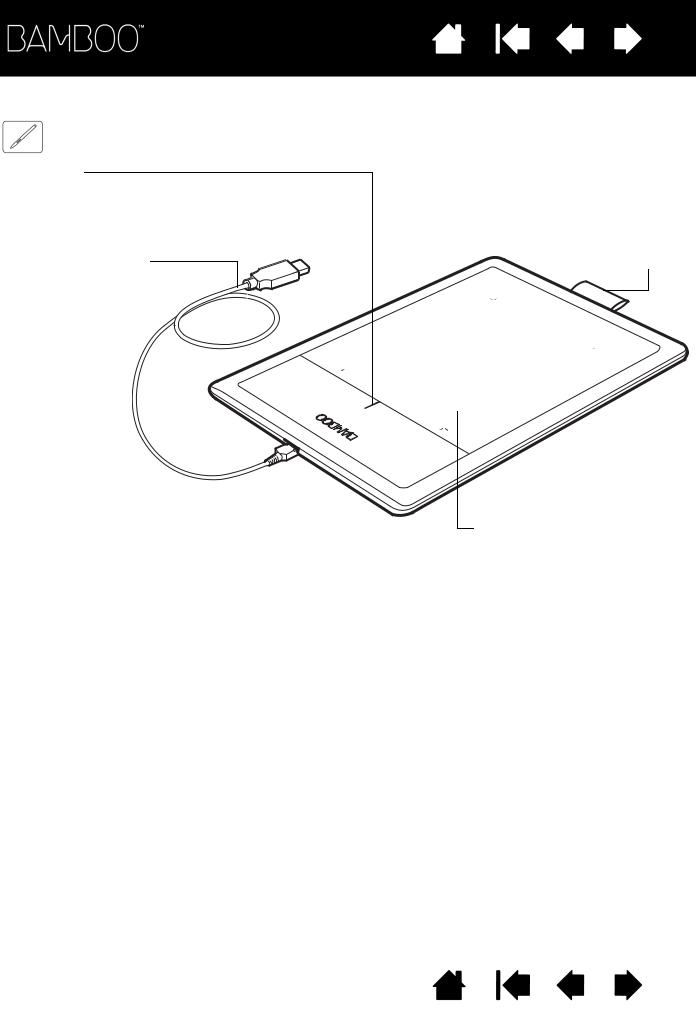
Contents Index
BAMBOO PEN TABLET
Status LED
Glows blue when Bamboo is connected to an active USB port.
Brightens when using the pen.
USB cable, detachable
Disconnect the USB cable when storing Bamboo. Do not wrap the cable around the tablet.
8
Pen holder
Bamboo Pen
Active area
This is the active area for pen input. Learn about your pen and the pen experience with Bamboo.
Contents Index
8
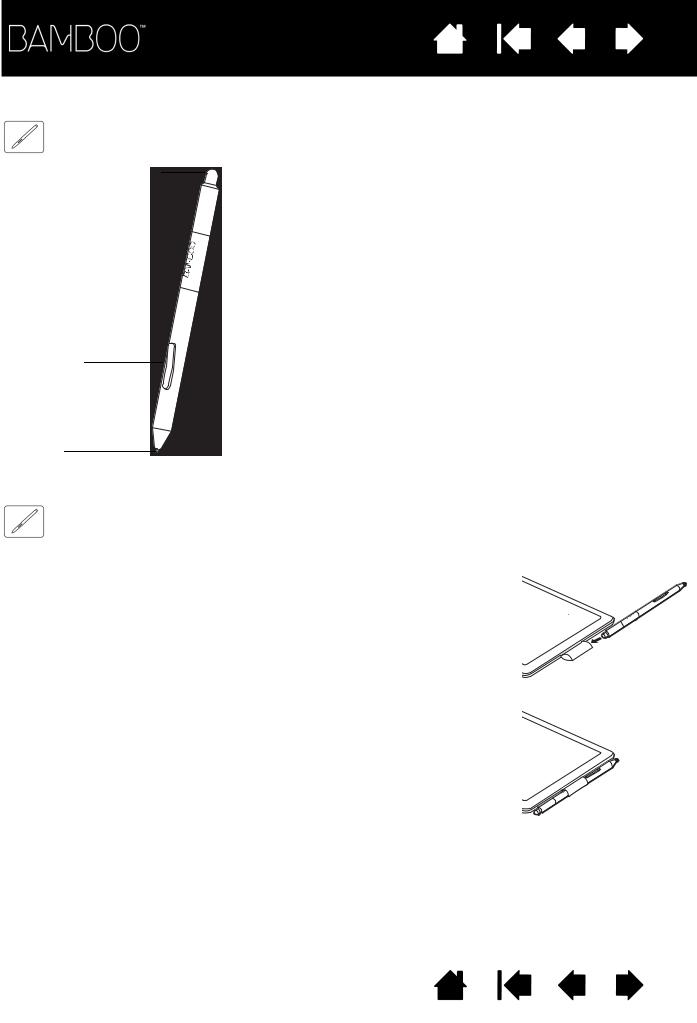
Contents Index
9
PEN
Eraser (when equipped)
Pen buttons
Replaceable nib (pen tip)
Pen
Cordless, battery-free, and pressure sensitive. Use this freehand tool for image editing and creating natural-looking pen strokes. It is also an efficient tool for document annotation and taking notes in applications that support handwriting recognition.
You will find the pen ideally suited to enhance your workflow by enabling the pen and digital ink features found within Microsoft Windows 7, Vista, and Office 2007 or later. Take advantage of digital mark-up for collaborative editing and use digital ink to take notes in applications that support handwriting recognition.
Important: When not in use, place the pen in the pen holder or lay it flat on your desk. The eraser end of the pen should be inserted first into the loop. To maintain the sensitivity of your pen, do not store it in a container where it will rest on the tip or eraser.
Leaving the pen on the tablet may interfere with screen cursor positioning when using other pointing devices, or may prevent your computer from going to sleep.
PEN HOLDER
When not in use, store the pen in the pen holder.
•Insert the eraser end of the pen into the loop.
•Do not wedge the pen buttons inside the loop. Doing so may cause the buttons to be continually depressed and possibly fail.
Important: You can also lay the pen flat on your desk. Leaving the pen on the tablet may interfere with screen cursor positioning when using other pointing devices, or may prevent your computer from going to sleep.
Do not store the pen in a holder or stand other than the one provided with your Bamboo tablet or purchased from Wacom. The pen may be damaged if it falls out of an unsuitable stand. The sensitivity of your pen may be affected if stored in a container where it rests on the tip or eraser.
Contents Index
9
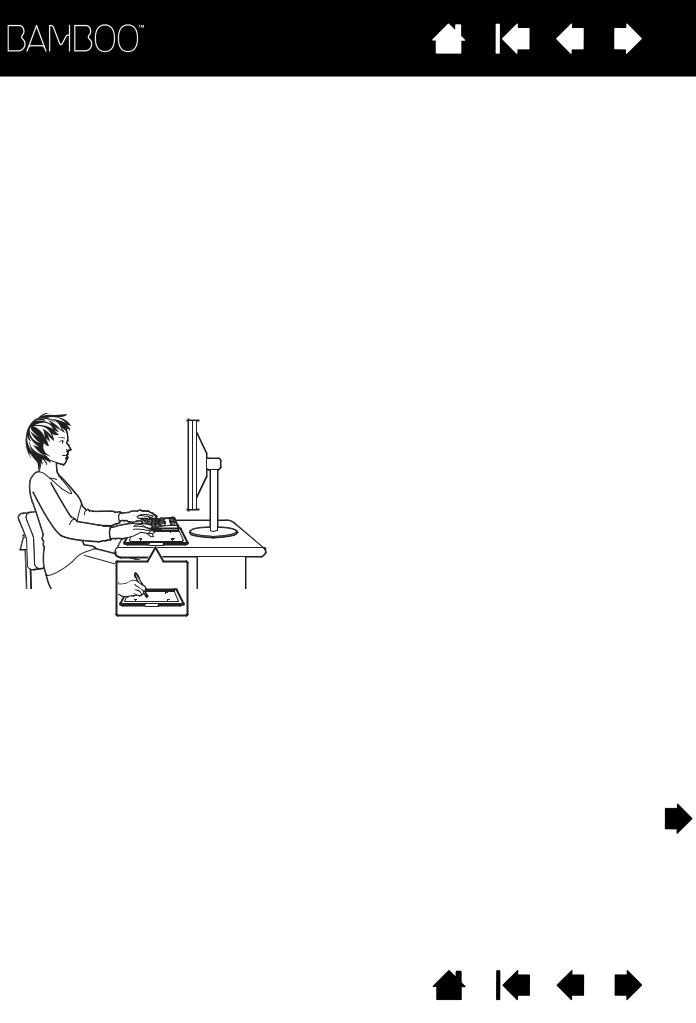
Contents Index
10
SETTING UP YOUR BAMBOO
To minimize fatigue, comfortably organize your work area. Position your tablet, pen, and keyboard for easy access without unnecessary reaching. Adjust your monitor so you can view it comfortably with minimum eyestrain. For best results, position the tablet so the screen cursor follows the same direction as your hand movements on the tablet.
Ergonomics
Configuring the tablet orientation
Understanding the tablet active area
Working with multiple monitors
Control panel basics
ERGONOMICS
•Maintain a good posture at all times.
• Use a gentle grip when working with the pen.
• Periodically shift your gaze from your computer and focus on other objects within the room. This will help to relax your eyes.
•Take short breaks between tasks to stretch and relax your muscles.
• Alternate tasks and tools throughout the day. Minimize awkward postures and repetitive movements that cause discomfort.
• Change your position if you feel any discomfort due to your work position.
• For right-handed use, position the tablet so the input (active) area is located to the right of the ExpressKeys. If using the tablet as a primary pointing device and mouse replacement, consider placing it to the right of your keyboard.
•For left-handed use, position the tablet with the input area to the left of the ExpressKeys. See configuring the tablet orientation. If using the tablet as a primary pointing device and mouse replacement, consider placing it to the left of your keyboard.
•If using the tablet primarily as a creative tool, consider placing the tablet below the keyboard, centered with respect to your monitor.
Note regarding RSI: Wacom makes no representation, promise or guarantee that Wacom products will cure or prevent, in whole or in part, mouse-induced repetitive stress symptoms, injuries or conditions. Individual results may vary. Always obtain competent medical advice to determine the most appropriate treatment for your specific situation.
Contents Index
10
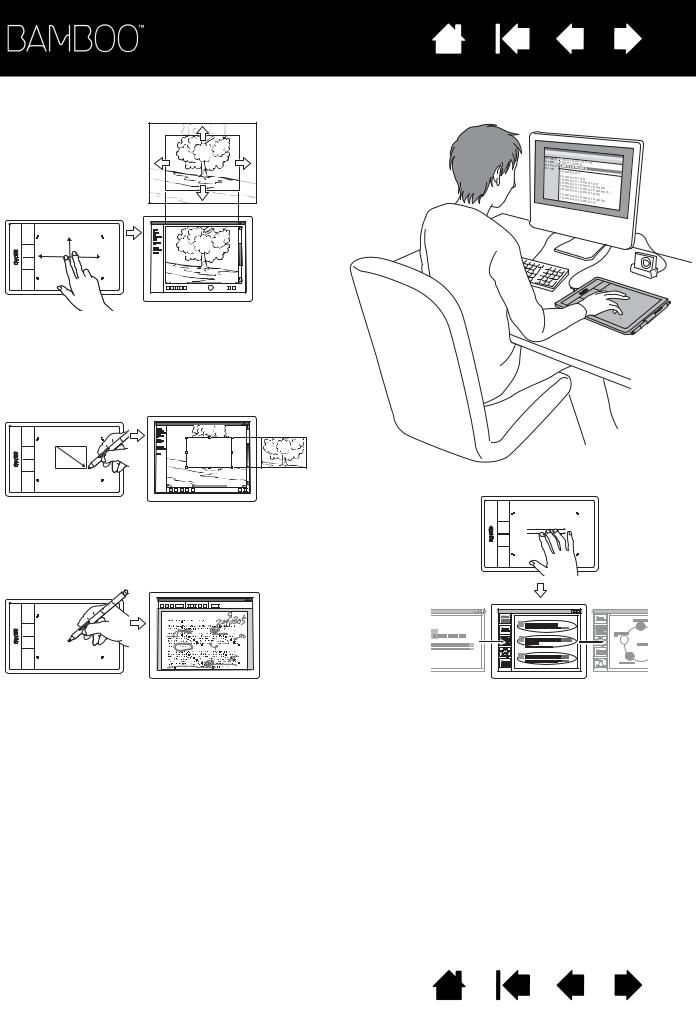
Contents Index
11
As you work, you will discover many ways of interacting with your Bamboo tablet. For example:
Visual browsing
Use two fingers on the tablet surface to scroll through and navigate visual media within an application.
Photo editing
Use the pressure-sensitive pen to edit images within a photo or image editing application.
Annotation
Simplify document reviews by using the pen to digitally mark-up and annotate documents.
Presentation
Swipe three fingers across the tablet surface to quickly move between slides in a presentation.
For details on these and other ways to work with your tablet, see the touch experience with Bamboo or the pen experience with Bamboo.
Contents Index
11
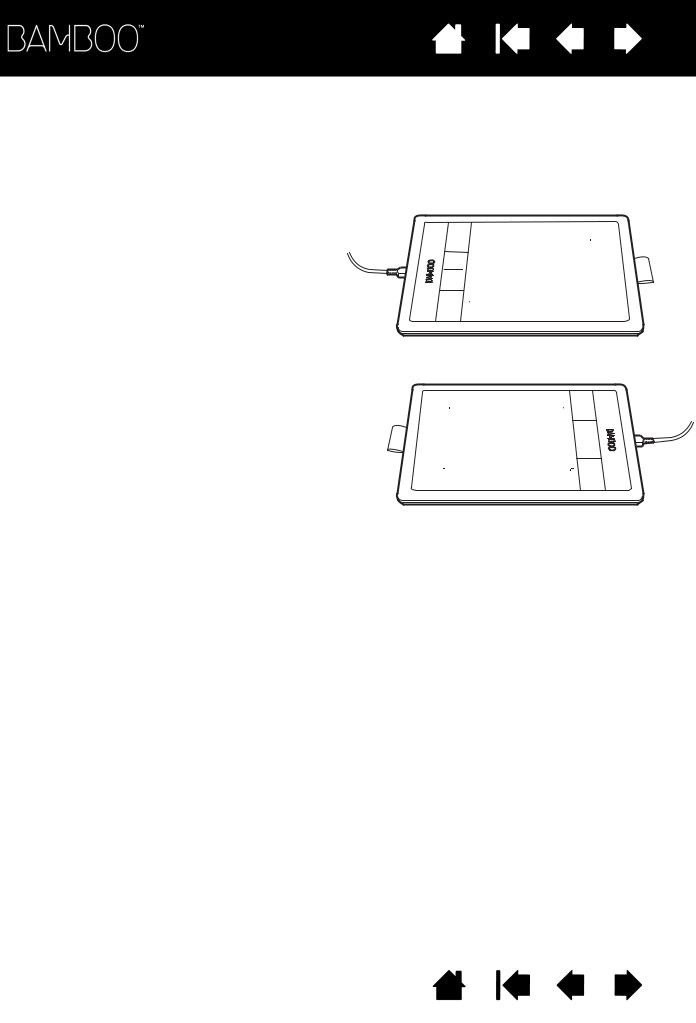
Contents Index
12
CONFIGURING THE TABLET ORIENTATION
When you first installed Bamboo, you were prompted to choose a default tablet orientation. The orientation you chose was used to determine the tablet default settings.
However, you can easily reconfigure Bamboo for leftor right-handed users at any time. The ExpressKey settings are automatically reconfigured when you change the handedness setting.
Right-handed operation:
•Open the Bamboo control panel and select the
TABLET tab. Choose RIGHT HANDED. The tablet driver automatically configures all aspects of the tablet for correct right-handed use.
• Next, physically rotate your tablet so the tablet ExpressKeys are positioned to the left.
Left-handed operation:
• Open the control panel and select the TABLET tab. Choose LEFT HANDED. The tablet driver automatically configures all aspects of the tablet for correct left-handed use.
• Next, physically rotate your tablet so the tablet ExpressKeys are positioned to the right.
Note: This procedure does not affect the default orientation. At the system log on and user switching screens, the tablet uses the default orientation you chose during the install process. To change the default orientation, you must re-install the tablet driver.
Contents Index
12
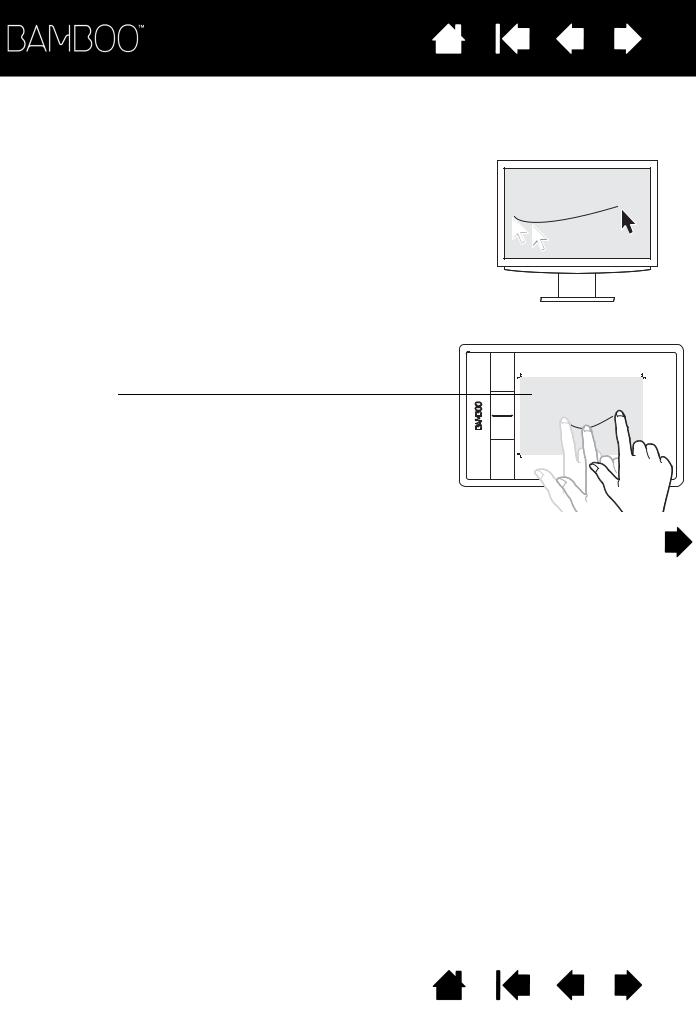
Contents Index
13
UNDERSTANDING THE TABLET ACTIVE AREA
Depending on your tablet model, Bamboo can accept pen input or both pen and touch input. Note, however, that pen and touch input cannot be used at the same time.
Touch input
On touch-sensitive tablet models, slide your finger(s) across the active area to position the screen pointer.
•Click or right-click.
• Scroll or zoom.
•Move between pages in most web browsers and document or
picture viewers.
• Switch between applications and perform other desktop functions.
Learn about the touch experience with Bamboo.
Tablet active area
The area of your Bamboo tablet that senses touch or pen input.
For tablet models that support both pen and touch input, touch is ignored whenever the pen tip or eraser is within the tablet proximity range. Lift the pen and your hand away from the tablet active area to enable touch input.
Contents Index
13
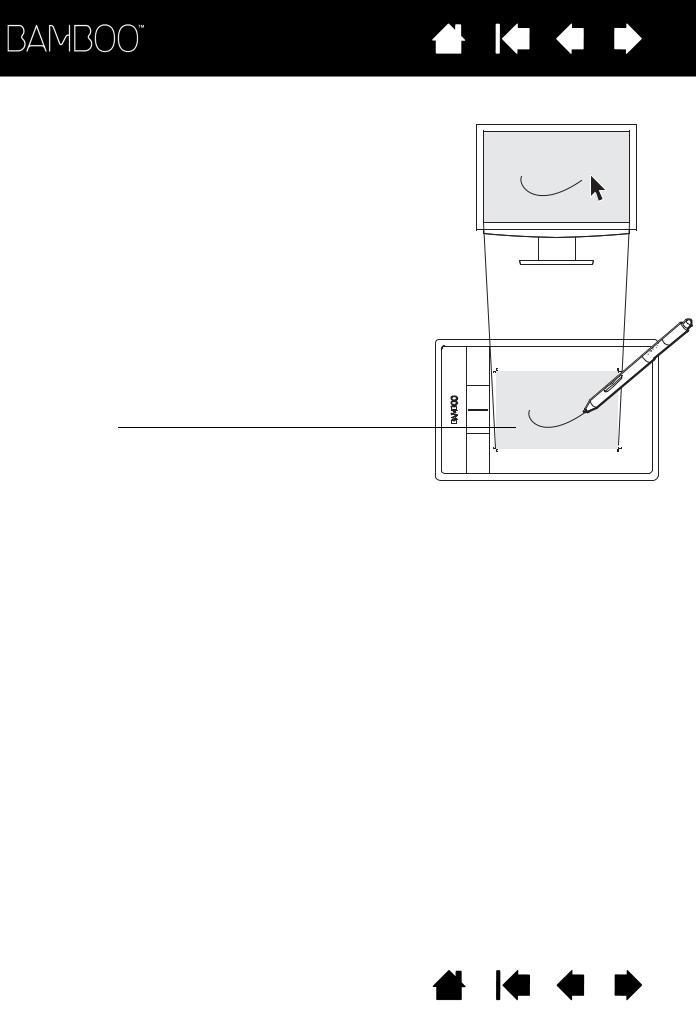
Contents Index
14
Pen input
The pen works only on the active area of the tablet.
Wherever you place the pen on the tablet, the screen pointer will jump to the corresponding point on the screen. The screen pointer indicates pen position, and follows the movement of the pen across the tablet surface.
Learn about the pen experience with Bamboo.
Note: The active area is a mapped representation of your computer screen(s). By default it uses the entire screen or all screens if you have multiple displays. You can customize the mapping relationship for pen input by setting the tablet mapping.
Tablet active area
The area of your Bamboo tablet that senses touch or pen input.
For tablet models that support both pen and touch input, touch is ignored whenever the pen tip or eraser is within the tablet proximity range. Lift the pen and your hand away from the tablet active area to enable touch input.
Contents Index
14
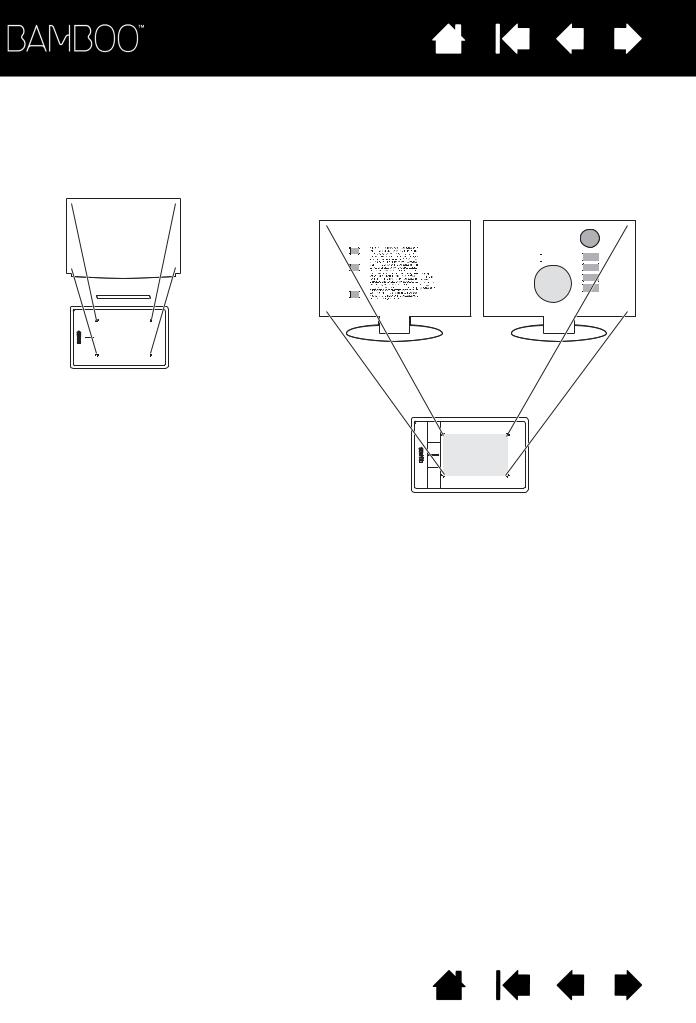
Contents Index
15
WORKING WITH MULTIPLE MONITORS
If your computer is equipped with more than one monitor, Bamboo will map to your monitors based upon how they are configured in the display properties control panel.
•If more than one monitor is in use and you are in extended monitor mode, the tablet maps to all monitors as if they were one large display.
|
|
|
|
|
|
|
|
|
|
Monitor 1 |
|
Monitor 2 |
||||||||||||||||||||
|
|
|
|
|
|
|
|
|
|
|
|
|
|
|
|
|
|
|
|
|
|
|
|
|
|
|
|
|
|
|
|
|
|
|
|
|
|
|
|
|
|
|
|
|
|
|
|
|
|
|
|
|
|
|
|
|
|
|
|
|
|
|
|
|
|
|
|
|
|
|
|
|
|
|
|
|
|
|
|
|
|
|
|
|
|
|
|
|
|
|
|
|
|
|
|
|
|
|
|
|
|
|
|
|
|
|
|
|
|
|
|
|
|
|
|
|
|
|
|
|
|
|
|
|
|
|
|
|
|
|
|
|
|
|
|
|
|
|
|
|
|
|
|
|
|
|
|
|
|
|
|
|
|
|
|
|
|
|
|
|
|
|
|
|
|
|
|
|
|
|
|
|
|
|
|
|
|
|
|
|
|
|
|
|
|
|
|
|
|
|
|
|
|
|
|
|
|
|
|
|
|
|
|
|
|
|
|
|
|
|
|
|
|
|
|
|
|
|
|
|
|
|
|
|
|
|
|
|
|
|
|
|
|
|
|
|
|
|
|
|
|
|
|
|
|
|
|
|
|
|
|
|
|
|
|
|
|
|
|
|
|
|
|
|
|
|
|
|
|
|
|
|
|
|
|
|
|
|
|
|
|
|
|
|
|
|
|
|
|
|
|
|
|
|
|
|
|
|
|
|
|
|
|
|
|
|
|
|
|
|
|
|
|
|
|
|
|
|
|
|
|
|
|
|
|
|
|
|
|
|
|
|
|
|
|
|
|
|
|
|
|
|
|
|
|
|
|
|
|
|
|
|
|
|
|
|
|
|
|
|
|
|
|
|
|
|
|
|
|
|
|
|
|
|
|
|
|
|
|
|
|
|
|
|
|
|
|
|
|
|
|
|
|
|
|
|
|
|
|
|
|
|
|
|
|
|
|
|
|
|
|
|
|
|
|
|
|
|
|
|
|
|
|
|
|
|
|
|
|
|
|
|
|
|
|
|
|
|
|
|
|
|
|
|
|
|
|
|
|
|
|
|
|
|
|
|
|
|
|
|
|
|
|
|
|
|
|
|
|
|
|
|
|
|
|
|
|
|
|
|
|
|
|
|
|
|
|
|
|
|
|
|
|
|
|
|
|
|
|
|
|
|
|
|
|
|
|
|
|
|
|
|
|
|
|
|
|
|
|
|
|
|
|
|
|
|
|
|
|
|
|
|
|
|
|
|
|
|
|
|
|
|
|
|
|
|
|
|
|
|
|
|
|
|
|
|
|
|
|
|
|
|
|
|
|
|
|
|
|
|
|
|
|
|
|
|
|
|
|
|
|
|
|
|
|
|
|
|
|
|
|
|
|
|
|
|
|
|
|
|
|
|
|
|
|
|
|
|
|
|
|
|
|
|
|
|
|
|
|
|
|
|
|
|
|
|
Example of tablet mapping to a single monitor.
Example of tablet mapping to the entire system desktop, which is displayed on two monitors.
•If your monitors are in mirror mode (both monitors display the same content), the tablet maps to the entire space on each monitor and the screen cursor is displayed on each monitor simultaneously.
See your hardware and operating system documentation for details on configuring your computer and operating system for use with multiple monitors.
Tips:
You can customize the tablet to map to a single monitor, or to a portion of the monitor area. See setting the tablet mapping.
When your system is configured with multiple monitors, you can assign the DISPLAY TOGGLE function to an ExpressKey. This enables you to toggle the current tablet mapping and screen cursor between the system desktop or primary display and your other monitors. See working with Display Toggle.
CONTROL PANEL BASICS
After mastering the basics of using your Bamboo tablet, you may want to customize the way touch or pen input works. The Bamboo control panel is where you customize your Bamboo tablet settings.
Opening the control panel
Control panel overview
Contents Index
15

Contents Index
16
USING YOUR BAMBOO
If you are new to using Bamboo, read the following sections.
The touch experience with Bamboo
The pen experience with Bamboo
THE TOUCH EXPERIENCE WITH BAMBOO
Bamboo is designed to enhance the way you work. Touch input enables you to interact with a computer using only your fingertips on the Bamboo tablet.
First learn the basic actions to navigate and perform typical mouse operations. Then learn the gestural movements to control other functions such as scrolling, zooming, and rotating.
Touch input is activated whenever you touch the tablet active area.
•When using multi-finger input methods, you can generally position your fingers as far apart as is comfortable. Your fingers must remain within the active area. However, placing your fingers too closely together may be interpreted by the tablet as input from a single finger, or the tablet may confuse which finger initiated or performed an action or gesture.
•As you learn the different input methods, experiment with what works best for you. Take care to prevent accidental touch input. For example, if your small finger or the palm of your hand touches the active area of the tablet while you are navigating or performing a touch action, then your input may be interrupted or you may trigger an unanticipated right-click.
Note: For tablet models that support both pen and touch input, the pen disengages touch input whenever the pen tip or eraser is within the tablet proximity range. Lift the pen and your hand away from the tablet active area to enable touch input.
Navigating with touch
Customizing touch
ExpressKey basics
Customizing the ExpressKeys
Customizing the Pop-up Menu
Working with Display Toggle
Contents Index
16
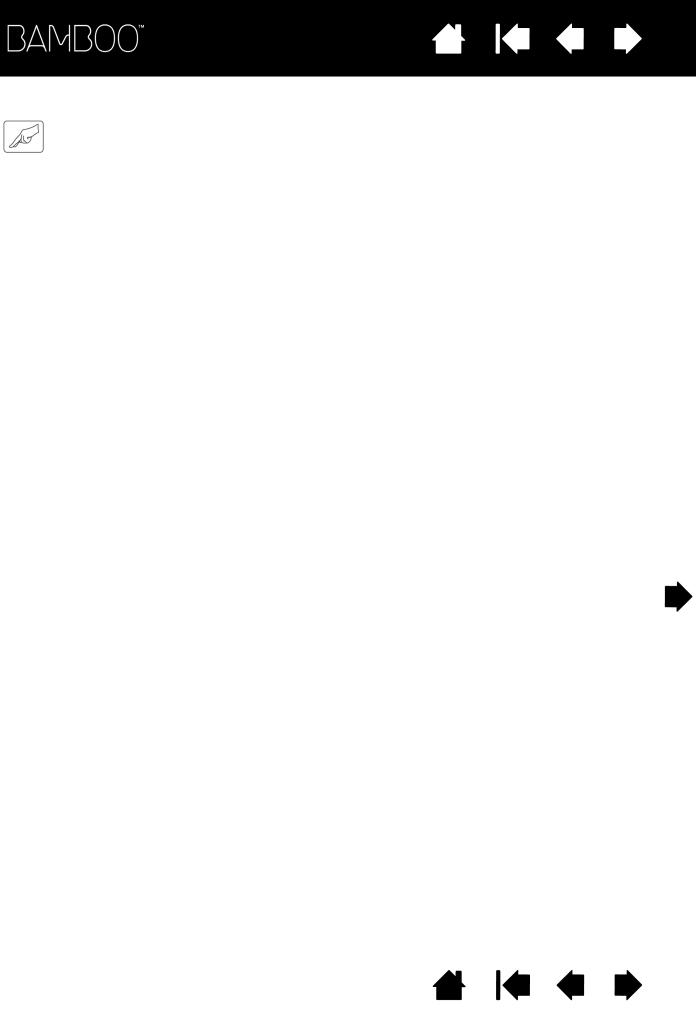
Contents Index
17
NAVIGATING WITH TOUCH
The touch input feature of your Bamboo tablet enables you to control a computer using only your fingertips on the tablet surface. See understanding the tablet active area.
Before learning how to control your computer with touch input, familiarize yourself with the following concepts:
CONCEPT |
DESCRIPTION |
|
|
Track |
Touch and move a single finger across the tablet surface. |
|
|
Tap |
Touch and lift a single finger from the tablet. Tap with two fingers to |
|
perform different functions. |
|
|
Pan |
Touch the tablet surface with two fingers and move them in the same |
|
direction. |
|
|
Swipe |
Touch the tablet surface with three or four fingers and move them in a |
|
horizontal or vertical direction. Your fingers should be spaced slightly |
|
apart from one another. |
|
|
Pinch |
Touch the tablet with two fingers spaced slightly apart. While still |
|
touching the tablet surface, move or ‘pinch’ your fingers together. |
|
|
Expand |
Touch the tablet with two fingers spaced closely together. While still |
|
touching the tablet surface, move your fingers apart. |
|
|
Twist |
Touch the tablet with two fingers spaced slightly apart and move |
|
(rotate) them in a circular fashion, or move them in opposing directions. |
|
You can also hold one finger stationary and track your other finger |
|
around the stationary finger. |
You can customize your touch experience and also use the ExpressKeys to perform some touch functions.
Contents Index
17
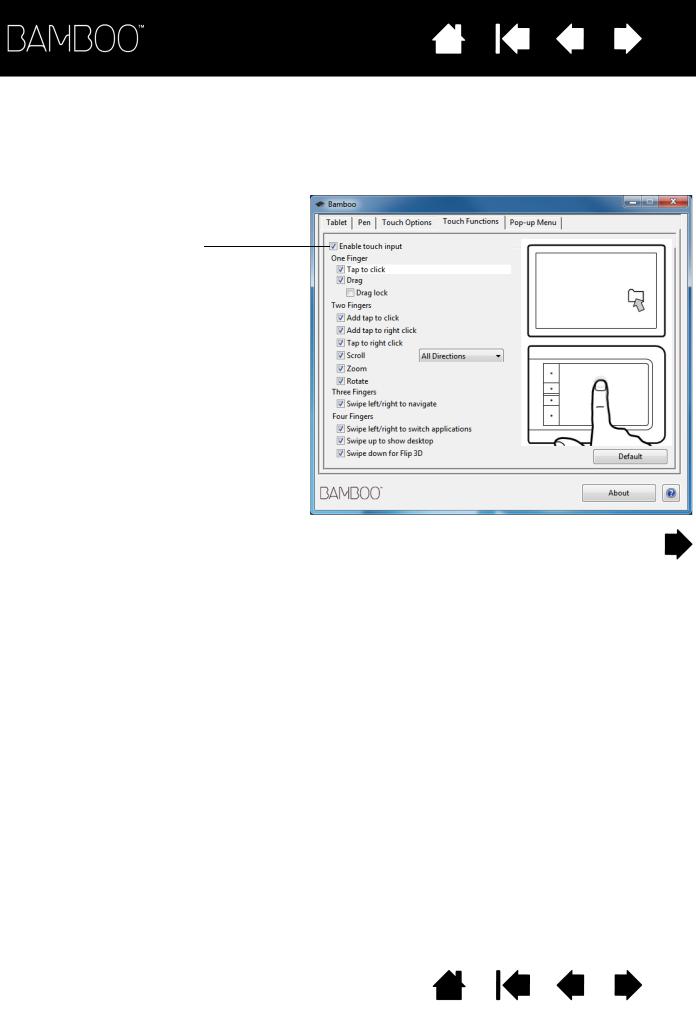
Contents Index
18
Touch input options can be enabled or disabled within the Bamboo control panel. Touch actions and gestures are available when selected in the TOUCH FUNCTIONS tab.
•Basic actions enable you to navigate and perform typical mouse operations.
•Gestures enable you to scroll, zoom, rotate, and perform other functions. Some gestures may provide a visual cue on your display screen to indicate when the gesture has been recognized by your Bamboo.
Uncheck to disable touch input.
Contents Index
18
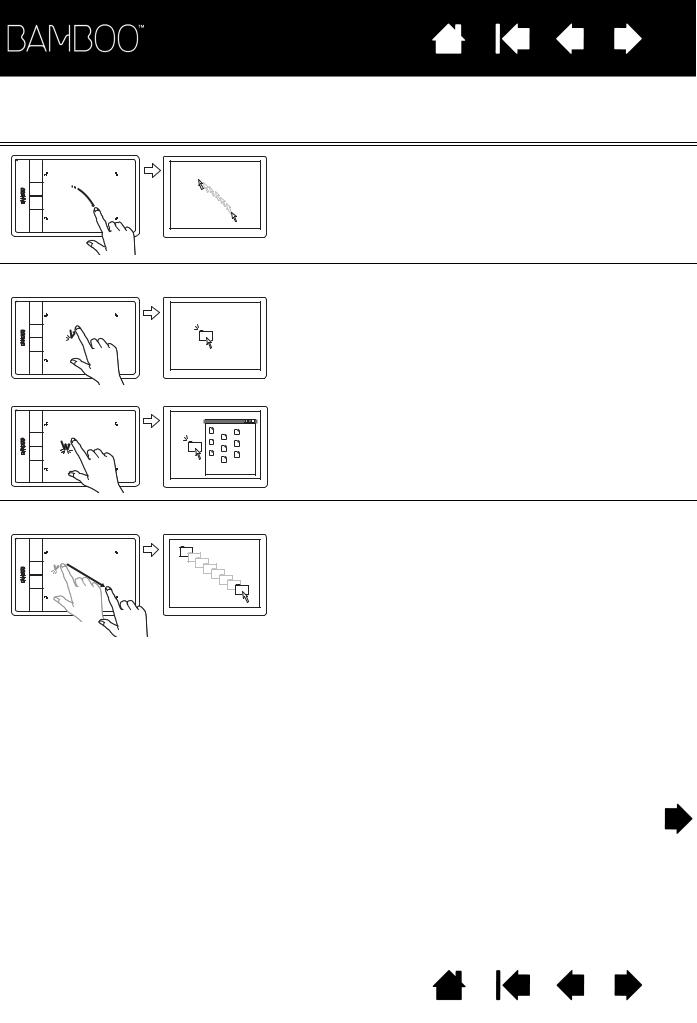
Contents Index
19
ONE-FINGER ACTIONS
Track
Use a single finger to move the screen cursor. Touch and slide your finger across the tablet surface.
TAP TO CLICK |
Click (single-finger tap) |
Using a single finger, track to an item. Lift your finger and tap to select.
Alternatively, track to an item and then press an ExpressKey set to CLICK.
Double-click
Using a single finger, track to an item. Lift your finger and tap twice.
DRAG |
Select and drag (DRAG LOCK disabled) |
|
Using a single finger, tap on an item to select. Then again |
|
quickly tap down and track (slide) your finger across the |
|
tablet to drag. Lift your finger to release the item. |
|
Alternatively, drag by tracking to an item, pressing an |
|
ExpressKey set to CLICK, and then continuing to move your |
|
finger across the tablet surface. Release the ExpressKey to |
|
release the item. |
|
Tips: |
|
You can select and drag multiple items on the system |
|
desktop: |
|
Windows: Press the CTRL or SHIFT key as you tap to |
|
select multiple items. |
|
Mac: Press the SHIFT or COMMAND key as you tap to |
|
select multiple items. |
|
You can also select and drag with two fingers. |
Contents Index
19

Contents |
Index |
|
20 |
DRAG LOCK |
Drag lock (DRAG LOCK enabled) |
|
Using a single finger, tap on an item to select. Then track |
|
(slide) your finger across the tablet to drag. Tap again to |
|
release the item. |
TWO-FINGER ACTIONS AND GESTURES
ADD TAP TO CLICK |
Select and drag |
|
Using a single finger, track to an item. Select by touching |
|
your thumb or a second finger to the left of that finger. If you |
|
will be dragging an item or selecting blocks of text, we |
|
recommend using two fingers instead of your finger and |
|
thumb. |
|
• To move the selected item, continue moving both fingers |
|
across the tablet. |
|
• To highlight a text block, continue moving both fingers |
|
across the tablet as you select text. |
|
• You can also extend a drag without releasing the |
|
selection. To do this, lift the first finger and move your |
|
second finger to a new position. Then again touch the |
|
first finger to the tablet and continue to drag with both |
|
fingers. |
|
Lift your thumb or second finger to release. |
|
Note: If the tablet is set for left-handed orientation, touch to |
|
the right of the primary finger. |
ADD TAP TO RIGHT CLICK |
Right-click |
|
Using a single finger, track to an item. Then with a second |
|
finger touch and release to the right of that finger. Releasing |
|
your finger issues a right-click and brings up a context |
|
menu at the screen cursor position. |
|
You can then track to an option in the menu and select it by |
|
tapping your finger. |
|
Note: If the tablet is set for left-handed orientation, touch to |
|
the left of the primary finger. |
Contents Index
20
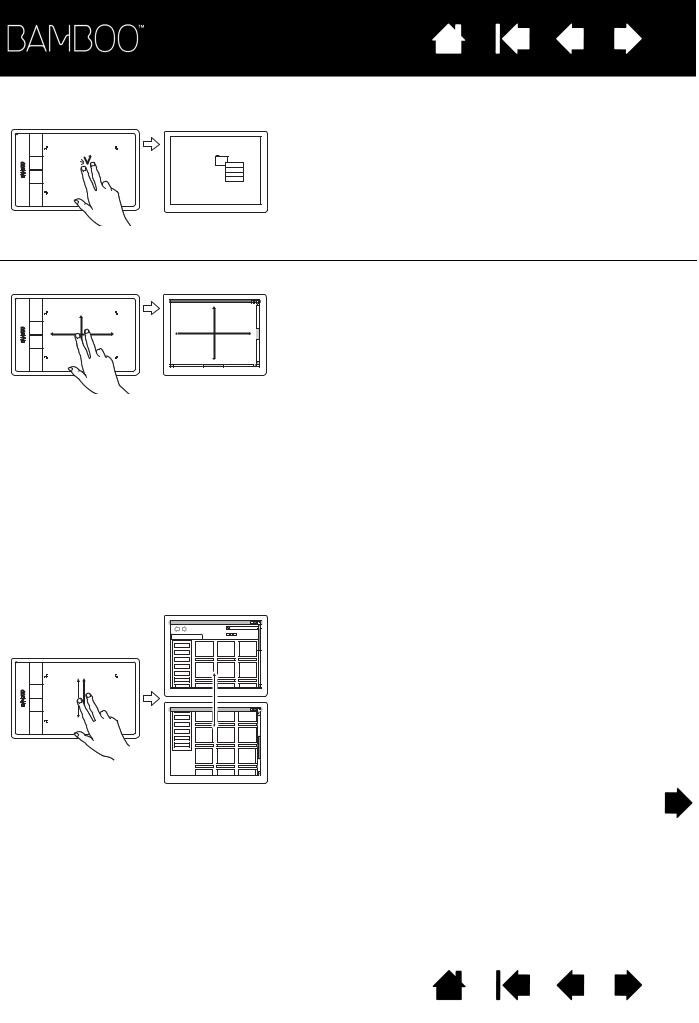
Contents |
Index |
|
21 |
TAP TO RIGHT CLICK |
Right-click (two-finger tap) |
|
To right-click and bring up a context menu at the screen |
|
cursor position, tap the tablet surface with two fingers |
|
spaced slightly apart. Use a quick tapping motion with both |
|
fingers at the same time. |
|
You can then track to an option in the menu and select it by |
|
tapping your finger. |
|
Alternatively, open a context menu by tracking to an item |
|
and then pressing an ExpressKey set to RIGHT CLICK. |
SCROLL |
Scroll |
|
Place two fingers on the tablet surface. Using a smooth |
|
motion, move your fingers together in parallel. |
|
• Scroll up by moving your fingers in an upward motion. |
|
• Scroll down by moving your fingers in a downward |
|
motion. |
|
• Scroll left by moving your fingers in a leftward motion. |
|
• Scroll right by moving your fingers in a rightward motion. |
|
Tips: |
|
Flick your fingers at the end of the gesture to |
|
continue scrolling for a short time after your fingers |
|
leave the tablet. |
|
For windows that scroll vertically and horizontally, |
|
move your fingers in any direction and the document |
|
view will follow. |
|
If you prefer vertical only scrolling, from the Bamboo |
|
control panel TOUCH FUNCTIONS tab select VERTICAL |
|
from the SCROLL drop-down menu. |
|
Fast scroll |
|
Quickly move (or flick) two fingers together, lifting your |
|
fingers at the end of the motion. |
|
• Fast scroll up by flicking your fingers in an upward |
|
motion. |
|
• Fast scroll down by flicking your fingers in a downward |
|
motion. |
|
Note: Fast scrolling works only for vertical scrolling. |
Contents Index
21

ZOOM
Contents Index
22
Zoom
First place two fingers on the tablet surface.
•Zoom-in by moving (expanding) your fingers away from
one another.
• Zoom-out by moving (pinching) your fingers toward one another.
Note: If zoom functions do not operate correctly within
Adobe® Photoshop®, verify that the ZOOM WITH
SCROLL WHEEL function is not selected within the
Photoshop PREFERENCES options.
Contents Index
22
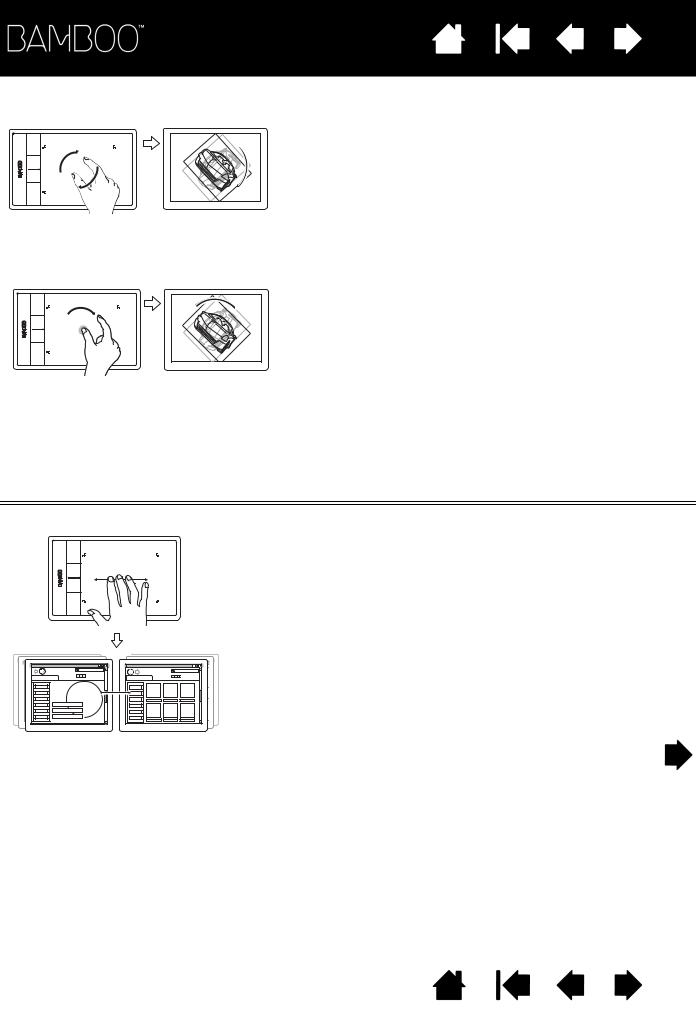
Contents |
Index |
|
23 |
ROTATE |
Rotate (two finger rotate) |
|
Place two fingers diagonally on the tablet surface and then |
|
rotate them clockwise or counter-clockwise. |
|
For best recognition of this gesture, start with your fingers |
|
positioned diagonally on the tablet surface and keep them |
|
at least 25 mm (1 inch) apart. |
|
Note: The rotation gesture may work differently depending |
|
on the application you are working with. For example, |
|
rotation may work smoothly, in 90-degree |
|
increments, or not at all. |
|
Rotate (rotate around finger) |
|
Place two fingers diagonally on the tablet surface. Keep one |
|
finger stationary and move the other finger around it. |
|
For best recognition of this gesture, start with your fingers |
|
positioned diagonally on the tablet surface and keep them |
|
at least 25 mm (1 inch) apart. |
|
Note: The rotation gesture may work differently depending |
|
on the application you are working with. For example, |
|
rotation may work smoothly, in 90-degree |
|
increments, or not at all. |
THREE-FINGER GESTURES |
|
SWIPE LEFT/RIGHT TO NAVIGATE |
Forward or Back (swipe right or left) |
|
Swipe using three fingers spaced slightly apart, lifting your |
|
fingers at the end of the motion. |
|
• Send a ‘Forward’ command in most browsers and |
|
picture viewers by swiping to the right. |
|
• Send a ‘Back’ command in most browsers and picture |
|
viewers by swiping to the left. |
|
Tips: |
|
Swiping is similar to using the right and left arrow |
|
keys in document viewers. |
|
Use the swipe gestures to page forward or back in |
|
most web browsers. |
Contents Index
23

Contents |
Index |
|
24 |
FOUR-FINGER GESTURES |
|
SWIPE LEFT/RIGHT TO SWITCH APPLICATIONS |
Switch applications |
|
Using four fingers spaced slightly apart, move your fingers |
|
left or right to open the application switcher. Then using a |
|
single finger, move left or right to highlight an application. |
|
Tap to select an application. |
|
Windows XP: Using four fingers, move them left or right to |
|
open the application switcher. Swipe your fingers again to |
|
open the next application in the list. |
SWIPE DOWN FOR FLIP 3D/EXPOSÉ |
Open Flip 3D (Windows) or Exposé (Mac) |
|
Using four fingers spaced slightly apart, swipe down. |
|
• Windows: Your first swipe opens Flip 3D. Swipe down |
|
again to close Flip 3D. Not available for Windows XP. |
|
Alternatively, move your fingers down 1 cm (0.4 inch) to |
|
open Flip 3D. Without lifting your fingers, continue |
|
moving downward to select applications to the left, or |
|
move upward to select applications to the right. Lift any |
|
finger to dismiss Flip 3D. |
|
• Mac: Your first swipe opens Exposé. Swipe down again |
|
to close Exposé. |
Contents Index
24

|
|
Contents |
Index |
|||||||
|
|
|
|
|
|
|
|
|
|
25 |
SWIPE UP TO SHOW DESKTOP |
Show Desktop |
|||||||||
|
|
|
|
|
|
|
|
|
|
Using four fingers spaced slightly apart, swipe up to show |
|
|
|
|
|
|
|
|
|
|
the desktop. Swipe up again to move your open windows |
|
|
|
|
|
|
|
|
|
|
back to the desktop. |
|
|
|
|
|
|
|
|
|
|
|
|
|
|
|
|
|
|
|
|
|
|
|
|
|
|
|
|
|
|
|
|
|
|
|
|
|
|
|
|
|
|
|
|
|
|
|
|
|
|
|
|
|
|
|
|
|
|
|
|
|
|
|
|
|
|
|
|
|
|
|
|
|
|
|
|
|
|
|
|
|
|
|
|
|
|
|
|
|
|
|
|
|
|
|
|
|
|
|
|
|
|
|
|
|
|
|
|
|
|
|
|
|
|
|
|
|
|
|
|
|
|
|
|
|
|
|
|
|
|
|
|
|
|
|
|
|
|
|
|
|
|
|
|
|
|
|
|
|
|
|
|
|
|
|
|
|
|
|
|
|
|
|
|
|
|
|
|
|
|
|
|
|
|
|
|
|
|
|
|
|
|
|
|
|
|
|
|
|
|
|
|
|
|
|
|
|
|
|
|
|
|
|
|
|
|
|
|
|
|
|
|
|
|
|
|
|
|
|
|
|
|
|
|
|
|
|
|
|
|
|
|
|
|
|
|
|
|
|
|
|
|
|
|
|
|
|
|
|
|
|
|
|
|
|
|
|
|
|
|
|
|
|
|
|
|
|
|
|
|
|
|
|
|
|
|
|
|
|
|
|
|
|
|
|
|
CUSTOMIZING TOUCH
Use the Bamboo control panel to customize the touch input options for the way you like to interact with your tablet and computer.
Opening the control panel
Control panel overview
Customize your touch experience
Contents Index
25
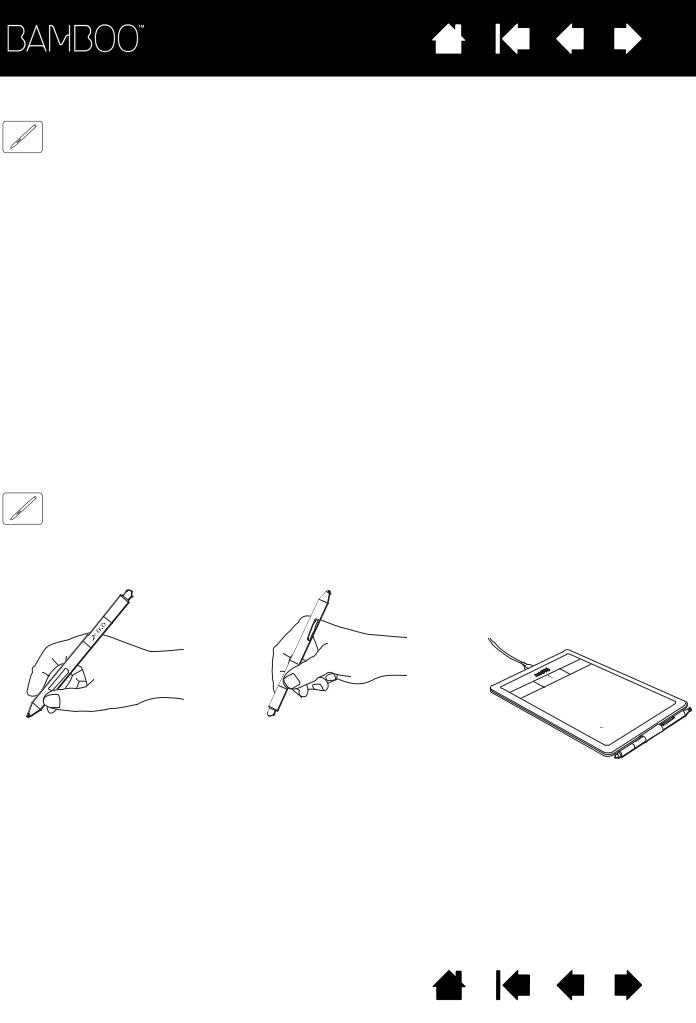
Contents Index
26
THE PEN EXPERIENCE WITH BAMBOO
Bamboo is designed to enhance the way you work. Bamboo tablet models equipped for pen input enable you to interact with a computer using the pen on the active area of the tablet.
Note: For Bamboo tablets that support both pen and touch input, the pen disengages touch input whenever the pen tip or eraser (when equipped) is within the tablet proximity range. Lift the pen and your hand away from the tablet active area to enable touch input. If you experience unintended touch input from your hand, manually disable touch by pressing an Expresskey set to TOUCH TOGGLE. When done working with the pen, press the ExpressKey again to enable touch. See customizing tablet and ExpressKey functions. You can also use the Bamboo control panel to disable touch input.
Holding the pen
Using the pen on the tablet
Customizing pen input
ExpressKey basics
Customizing the ExpressKeys
Customizing the Pop-up Menu
Working with Display Toggle
HOLDING THE PEN
Hold the pen like you would hold a normal pen or pencil. Make sure the pen buttons are in a convenient location where you can toggle them with your thumb or forefinger, but not accidently press them while drawing or positioning with the pen. Tilt the pen in any way that feels most comfortable.
When you are not using the pen, store it in the pen holder. The eraser end of the pen should be inserted first into the loop.
Position for drawing and navigation |
Position for erasing |
Important: When not in use, place the pen in the pen holder or lay it flat on your desk. To maintain the sensitivity of your pen, do not store it in a container where it will rest on the tip or eraser (when equipped). Leaving the pen on the tablet may interfere with screen cursor positioning when using other pointing devices, or may prevent your computer from going to sleep.
Contents Index
26

Contents Index
27
USING THE PEN ON THE TABLET
There are four basic techniques for using the pen: positioning, clicking, double-clicking, and dragging. If you are unfamiliar with using the pen, try the exercises on the following pages.
Positioning
Clicking
Dragging
Using the pen buttons
Writing and drawing with pressure sensitivity
Erasing
Eye-hand coordination exercise
POSITIONING
Use the pen to position the pointer (or cursor) on your screen.
Lift the pen and place the pen tip on the tablet active area. The cursor jumps to the new location.
Move the screen cursor by hovering the pen over the tablet surface. Do this without touching the tablet surface, but while still keeping the pen tip within proximity of the tablet.
To select an icon or folder, use your pen to position the screen cursor over the object. Press down to select.
Tips:
If you find using a pen to be somewhat difficult, try the eye-hand coordination exercise.
Pointing is easier when you orient the tablet square to the computer monitor so the screen cursor follows the same direction as your hand movements on the tablet.
Contents Index
27
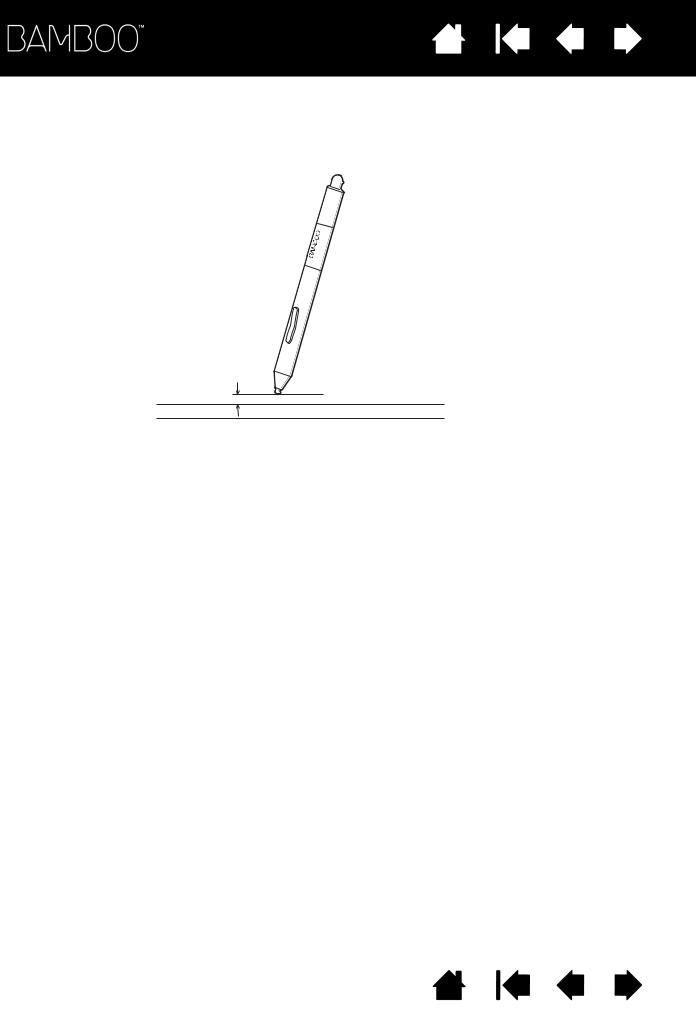
Contents Index
28
You can set the pen to position the screen cursor two different ways (see setting the tablet mapping).
•In pen mode, wherever you place the pen on the tablet, the screen cursor will jump to a corresponding point on the display screen. The screen pointer indicates pen position, and follows the movement of the pen across the tablet surface. This is the default setting for the pen.
When positioning the screen cursor and operating a pen button, the pen tip needs to be within 7 mm (0.28 inch) of the tablet surface. The pen tip does not need to touch the tablet in order to move the screen cursor or use a pen button.
16 mm (0.63 inch) proximity range
7 mm (0.28 inch) proximity
•In mouse mode you move the cursor with a “pick up and slide” motion similar to using a mouse.
Contents Index
28
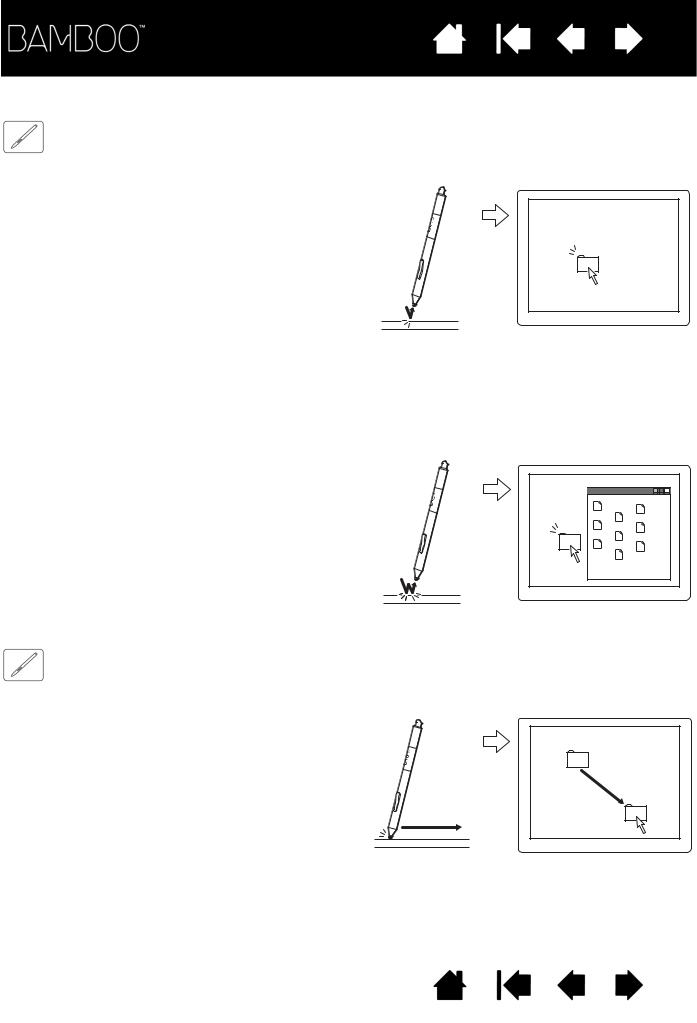
Contents Index
29
CLICKING
Click to highlight or select an item on the screen. Double-click to open it.
Clicking. Tap the pen tip once on the tablet, or press the pen tip on the tablet with enough force to register a click. Try clicking on a folder icon by moving the screen cursor over the icon and pressing down on the pen tip. The folder should highlight when you press.
If CLICK SOUND is selected in the Bamboo control panel and your computer speakers are on, then you will hear a “click” sound when the pen tip is pressed hard enough to generate a button click. Adjust your speaker volume as necessary.
Tip: Configure Windows to select when hovering the pen over an icon and to launch the icon with a single click. To turn on this feature, first open a folder.
Windows 7 and Vista: From the ORGANIZE pull-down menu choose FOLDER AND SEARCH OPTIONS.... From the GENERAL tab select SINGLE-CLICK TO OPEN AN ITEM (POINT TO SELECT).
Windows XP: From the TOOLS pull-down menu choose FOLDER OPTIONS.... From the GENERAL tab select SINGLE-CLICK TO OPEN AN ITEM (POINT TO SELECT).
Double-clicking. Quickly tap the tablet twice in the same place with the pen tip. This is like clicking twice with a mouse button. Try double-clicking on a folder icon to open it.
Tip: Set a pen button to DOUBLE CLICK. This is easier than tapping twice with the pen tip, and is the preferred method of doubleclicking with a pen.
DRAGGING
Dragging is used to select and move objects on the monitor screen.
First point to an object. Then press the pen tip to the tablet and slide it across the tablet surface. The selected object will move across the display screen.
To select text within a document, move the screen cursor to the beginning of a text line. Then drag the pen across the tablet to highlight the text.
Contents Index
29
